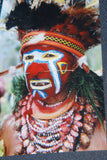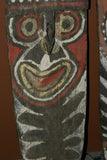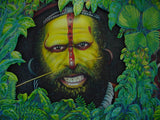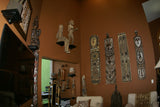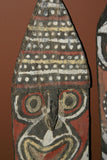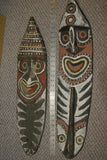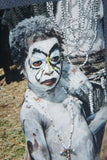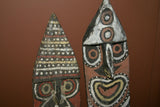RARE MINDJA MINJA HAND CARVED YAM HARVEST UNIQUE CELEBRATION MASK POLYCHROME WITH NATURAL PIGMENTS, PAPUA NEW GUINEA PRIMITIVE ART HIGHLY COLLECTIBLE & EXTREMELY DECORATIVE 11A10: 29"X 7”X 1”
ITEM 11A10
Very rare Mindja Minja yam festival mask collectible
SEEN ON THE LEFT ON PHOTO 1
THIS IS A LIQUIDATION AT REDUCED PRICE, WE CLOSED OUR ACTUAL STORE DOORS
POWERFULLY DECORATIVE!!
I have seen these pieces in Australia for up to 10,000.00 each
Photo 6 here shows how dramatic primitive art makes a home look, if you like primitive art that is.
Rare OLD Mindja Minja Hand carved interesting mask-face with phallic nose: Yam harvest Mask
Papua New Guinea Primitive Art
ITEM 11A10
POWERFULLY DECORATIVE!!
I have seen these pieces in Australia for up to 10,000.00 each
Photo 6 here shows how dramatic primitive art makes a home look, if you like primitive art that is.
Rare OLD Mindja Minja Hand carved interesting mask-face with phallic nose: Yam harvest Mask
Papua New Guinea Primitive Art
ITEM 11A10
(Seen on most of the photos and on left on photo 1)
Measures: 29"X 7" X 1"
Papua New Guinea Oceanic Art
Rare Harvest Mindja or Minja Figure mask carving seen on most of the photos
Clan Spirit Mask Cult head Figure with phallic symbol nose
from the so called "Waskuk" Upper Sepik region and used during ceremonies of the Yam harvest.
Although it looks like a large mask, such a hand carved wood figure was not worn but hung in the men's house or haus tambaran and used during secret celebrations and festivals as the important yam festival. It was hand carved with primitive tools and painted extensively with black, white and red clay pigments, made from natural sources which are still very bright.
Two groups live on and around the Ambunti Mountains: the Kwoma and the Nukuma. They are often incorrectly referred to collectively as the Waskuk or Washkuk.
Both cultures are yam-based, unlike the sago-based cultures of the Middle Sepik. The annual yam cult cycle uses three terms to refer to the complex rituals and to the objects and social groups associated with them. Yina, mindja and nogwi carvings are linked with their respective ceremonies which take place in the Haus Tambarans after the yam harvest.
Two groups live on and around the Ambunti Mountains: the Kwoma and the Nukuma. They are often incorrectly referred to collectively as the Waskuk or Washkuk.
Both cultures are yam-based, unlike the sago-based cultures of the Middle Sepik. The annual yam cult cycle uses three terms to refer to the complex rituals and to the objects and social groups associated with them. Yina, mindja and nogwi carvings are linked with their respective ceremonies which take place in the Haus Tambarans after the yam harvest.
All our collector and rare items come with pages and pages of research about provenance, and with history of the tribes and photos as well, depending on item and whenever possible. When shipping internationally, we group ship multiple purchases to save you money, and find the best rates available. If you have any questions or want to see research conducted on this piece and photos of tribes, tell us.
Masks, statues and carvings of Papua New Guinea’s cultures serve a variety of spiritual, cultural and decorative purposes. Most of the carvings found in PNG are from the Sepik region, where the production and use of masks, among other things, is an important part of traditional culture. Ancestral masks, for example, represent deceased clan ancestors, totemic creatures that assist the tribe by interceding on a high plane to provide food, prevent and cure illness, while spirit masks embody tribal spirits who inhabit the surrounding jungle, & may come to the help of the tribe to counterattack sorcery spells meant to arm them.
Ancestors assist one's life by interceding on a high plane to provide food, prevent and cure illness, acquire stature, and counter sorcery attempted via the ancestor spirit plane. These are examples of beautiful rare original standing masks of Ancestral figures from Papua New Guinea (above and next page): hand-carved wood adorned with rattan basketry, cassowary feathers and hand-painted with clay-based colors, shell eyes & clan animal at the top.
If a village or clan has a lot of bad luck, the whole group may change their names and buy the rights to use masks from another clan in a different village in an attempt to fool the bad spirits or sorcerers. The resulting masks usually display characteristics of both groups. Each Sepik River village otherwise is independent and has a distinctive style. No two masks can ever be exactly the same either. Each is crafted by a different artist, representing a different ancestor or spirit, and is therefore unique. (As a matter of fact, copying is forbidden and sentenced by local law unless there is a formal agreement between the parties involved.)
The men carve masks from indigenous wood. Paint is made from earth pigments and charcoal. Masks can be decorated with shells, pig tusks, and Cassowary feathers. Few masks are worn directly over the face, which explains why many lack holes for eyes. They may be part of a large cone-shaped wicker framework for a dance costume called a tumbuan. Other masks are made only for display in the men's Haus to attract powerful and useful spirits. Masks often refer to a clan totem such as crocodile or eagle usually represented carved on the forehead. New masks may appear when a man dreams a spirit and carves a mask to represent it.
Papua New Guinea Oceanic Art
Rare Harvest Mindja or Minja Figure mask carving seen on most of the photos
Clan Spirit Mask Cult head Figure with phallic symbol nose
from the so called "Waskuk" Upper Sepik region and used during ceremonies of the Yam harvest.
Although it looks like a large mask, such a hand carved wood figure was not worn but hung in the men's house or haus tambaran and used during secret celebrations and festivals as the important yam festival. It was hand carved with primitive tools and painted extensively with black, white and red clay pigments, made from natural sources which are still very bright.
Two groups live on and around the Ambunti Mountains: the Kwoma and the Nukuma. They are often incorrectly referred to collectively as the Waskuk or Washkuk.
Both cultures are yam-based, unlike the sago-based cultures of the Middle Sepik. The annual yam cult cycle uses three terms to refer to the complex rituals and to the objects and social groups associated with them. Yina, mindja and nogwi carvings are linked with their respective ceremonies which take place in the Haus Tambarans after the yam harvest.
Two groups live on and around the Ambunti Mountains: the Kwoma and the Nukuma. They are often incorrectly referred to collectively as the Waskuk or Washkuk.
Both cultures are yam-based, unlike the sago-based cultures of the Middle Sepik. The annual yam cult cycle uses three terms to refer to the complex rituals and to the objects and social groups associated with them. Yina, mindja and nogwi carvings are linked with their respective ceremonies which take place in the Haus Tambarans after the yam harvest.
All our collector and rare items come with pages and pages of research about provenance, and with history of the tribes and photos as well, depending on item and whenever possible. When shipping internationally, we group ship multiple purchases to save you money, and find the best rates available. If you have any questions or want to see research conducted on this piece and photos of tribes, tell us.
Masks, statues and carvings of Papua New Guinea’s cultures serve a variety of spiritual, cultural and decorative purposes. Most of the carvings found in PNG are from the Sepik region, where the production and use of masks, among other things, is an important part of traditional culture. Ancestral masks, for example, represent deceased clan ancestors, totemic creatures that assist the tribe by interceding on a high plane to provide food, prevent and cure illness, while spirit masks embody tribal spirits who inhabit the surrounding jungle, & may come to the help of the tribe to counterattack sorcery spells meant to arm them.
Ancestors assist one's life by interceding on a high plane to provide food, prevent and cure illness, acquire stature, and counter sorcery attempted via the ancestor spirit plane. These are examples of beautiful rare original standing masks of Ancestral figures from Papua New Guinea (above and next page): hand-carved wood adorned with rattan basketry, cassowary feathers and hand-painted with clay-based colors, shell eyes & clan animal at the top.
If a village or clan has a lot of bad luck, the whole group may change their names and buy the rights to use masks from another clan in a different village in an attempt to fool the bad spirits or sorcerers. The resulting masks usually display characteristics of both groups. Each Sepik River village otherwise is independent and has a distinctive style. No two masks can ever be exactly the same either. Each is crafted by a different artist, representing a different ancestor or spirit, and is therefore unique. (As a matter of fact, copying is forbidden and sentenced by local law unless there is a formal agreement between the parties involved.)
The men carve masks from indigenous wood. Paint is made from earth pigments and charcoal. Masks can be decorated with shells, pig tusks, and Cassowary feathers. Few masks are worn directly over the face, which explains why many lack holes for eyes. They may be part of a large cone-shaped wicker framework for a dance costume called a tumbuan. Other masks are made only for display in the men's Haus to attract powerful and useful spirits. Masks often refer to a clan totem such as crocodile or eagle usually represented carved on the forehead. New masks may appear when a man dreams a spirit and carves a mask to represent it.













